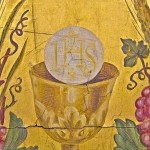
In many ways, The Young Pope is the second coming of Brideshead Revisited.
In the place of a millionaire with a teddy bear, we have a Pope with a pet kangaroo. Charles Ryder drinks champagne every afternoon; Lenny Belardo downs a Cherry Coke Zero every morning. The stately spires of Oxford have given way to the sumptuous splendor of Rome. And Papa Belardo can be as savagely witty as Waugh himself.
[NOTA BENE: many of the links in this post lead to YouTube videos to give you an experience of what the show looks and sounds like]
Brideshead accomplished two things. First, it demonstrated the capacity of television as a medium for serious art—and particularly for Catholic art. Secondly, it reinvigorated a certain kind of youthful, conservative Christianity. The Young Pope has done much the same for our own time. In its day, Brideshead was remarkable for the lush, artistic way it treated a story steeped in the Catholic faith. The Young Pope is the first series for the small screen since 1981 to do just that.
I have written elsewhere about The Young Pope’s unique visual and aural aesthetics. Sorrentino explores the luscious materiality of Catholicism through rich costumes, painstakingly re-created sets, and lavish rituals. He elicits top-notch performances from his cast, from Jude Law’s tour de force as Pope Pius XIII to Javier Cámara’s quietly melancholic Cardinal Gutierrez to Guy Boyd’s alternately fragile and threatening Archbishop Kurtwell. The story bristles with surreal images, often shot in soft-focus. The kangaroo lopes between darkened hedges. A bed dangles in mid-air. Nude FEMEN protesters silently materialize in the Vatican gardens, spelling out the word “BASTARD” across their bare breasts; seeing this, the Pope gives them a quizzically steely glance and lights a cigarette. The many comparisons to Twin Peaks are not misplaced. We are often not quite sure what is real and what is a dream, a hallucination, or a mystic vision.
But the series isn’t all spectacle. Nor is it, as some have argued, a drama primarily concerned with Vatican politics.
The Young Pope is far more interested in deeper questions of loneliness and power than the kabuki of pontifical inside baseball, just as Brideshead was ultimately about much more than the decline of the English aristocracy. Indeed, most of the actual debates that divide Catholics today seem uncontroversial and settled in the show; for example, every Mass in the show is said in Latin ad orientem. Since the Vatican is a culture built on celibacy, headed by the only man on earth who claims divine infallibility, it provides Sorrentino with an easy way to explore the psychological intersection of solitude and power. What’s more, the show manages to be spiritual without getting preachy (even with no fewer than five major homilies, all of which seem more like Shakespearean monologues than typical parish sermons).
Flashes of insight come in brief, strangely profound comments. When the Prime Minister of Greenland visits him, the Pope asks her what’s under all the ice that covers her country. She says that no one knows. He replies, “Could be God.” There’s another way that the series echoes Brideshead. When Brideshead Revisited first came out, it was an enormous success. As Thomas Vinciguerra, writing for the New York Times, recalls . . .












